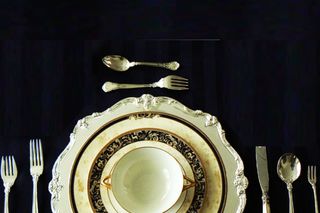
Manners Don’t Encourage Good Behavior, Just Class Discrimination
When we consider having manners a virtue, we exclude social classes that weren’t in on the arbitrary rule-making process.

“If it is possible to withdraw, it should be done alone,” wrote Desiderius Erasmus Roterodamus (Erasmus of Rotterdam), a 16th-century thinker who mused on etiquette. “But if not, in accordance with the ancient proverb, let a cough hide the sound.”
Farting. He’s laying down the social etiquette for farting.
The quote was reported by Smithsonian Magazine, and accompanied by other social codes Erasmus took great pleasure in disseminating to the public. He introduced society to no-nos such as double dipping, offering someone a half-eaten dish, shoving fingers into dishes with sauce, or picking up food with bare fingers. All the while, he spewed derision at those who did not follow his rules. He wrote, “For those lucky enough to be born into privilege, it is disgraceful when their manners do not match their position,” and, “Some people, no sooner than they have sat down, immediately stick their hands into the dishes of food. This is the manner of wolves,” reported National Geographic.
Erasmus’ quotes stemmed from the aristocracy’s desire to be different from common folk, to preserve social standing and associate fabricated sophistication with wealth. Even today, manners signify class; society welcomes those who have them and shuns those who don’t. But do these social etiquette rules mean anything?
Related on The Swaddle:
How Caste Has Always Shaped Desire, Desirability
Let’s take table manners as an example. National Geographic retraced table etiquette back to the Middle Ages, leading us to a simpler form of dining. Boards had cloth covers for diners to wipe their hands; the soup was drunk straight out of bowls, and cutlery was communal among diners. There was also no hierarchy among those who dined together; lords provided for their servants and dined with them.
The Renaissance period brought a shift in the above, first observed in Italy. A manual named Fifty Courtesies for the Table, written by Fra Bonvicino da Riva in the 1290s, influenced social etiquette and behavior. M.F.K. Fisher, author of The Art of Eating (1954), wrote about the arrival of the young Catherine de Medici in then-unrefined Paris, following her marriage to French prince Henry II. She found that “many people still laughed jeeringly at the ‘those Italian neatnesses called forks’ and gulped down great chunks of strongly seasoned meat from the knife-ends or their greasy fingers.” Horrified, de Medici was determined to transform table manners in Europe. As the crusade for ingraining table manners spread across the continent, aristocrats came up with random rules to make their dining habits special. This soon resulted in the manufacture of plates, cutlery, and specialized tablecloths.
The introduction of refinement into European society, at the time, was emblematic of the nobility’s desire to make a clear distinction between the wealthy and the poor. After all, how would they justify their exorbitant wealth, often earned by exploiting the labor of the poor, if not by perpetuating the notion that they were somehow ‘better’ than everybody else? There were pudding spoons and oyster forks and fish knives and asparagus tongs, completely unbeknownst to the common folk, and often, unnecessary and unaffordable. Children — young, impressionable and at the mercy of their pretentious parents — were not pardoned. A cookbook from 1890 read, “If children are carefully taught to hold the knife and fork properly, to eat without the slightest sound of the lips, to drink quietly, to use the napkin rightly, to make no noise of the implements of the table, and last but not least, to eat slowly and masticate the food properly, then they will always feel at their ease at the grandest tables in the land,” reports LoneHand.
But by the 18th and 19th centuries, land was no longer the only source of wealth, weakening aristocratic power. Common, unsophisticated folk had begun acquiring wealth through trading and manufacturing goods. By then, social etiquette rules were one too many, according to Kathryn Hughes, a journalist and professor of historical writing, according to her essay for the British Library. Social etiquette now covered “when to shake hands; how to bring a conversation politely to an end; how to sit and stand gracefully; what was meant by ‘RSVP’; how to deal with dirty nails or bad breath; how to style your beard; or how to conduct yourself at a dinner party, a picture gallery or church.”
Now that more people were acquiring wealth, social etiquette became an ever more important form of distinction and power-preservation. So what if you have the money — do you have the manners, style and an unspoken understanding of social orders? The nouveau riche, entranced with the desire to be upwardly-mobile in society, failed to question these arbitrary rules set by old farts trying to preserve their class standing. Soon, everyone wanted to adopt manners, style, and refinement to be one of the elite and run in sophisticated circles. And those who couldn’t conform were deemed unworthy of the affluence and the closed networks of old money.
Related on The Swaddle:
How The Indian Education System Reinforces Caste, Class Differences
Fast forward a few centuries, and hints of similar exclusionary phenomena still ring true today. This is partly because European countries established their social etiquette as the norm in all the countries they colonized. In India, Western etiquette combines with a wealth of traditions, cultures, languages and the pervasive caste system to make differentiating between people and performing superiority easier. Certain social etiquette is unique to the land, such as using namaste for greetings, leaving shoes at the door before entering someone’s house, or touching the feet of elders to signify respect. But these actions, too, contribute to cementing customs as signifiers of standing in society; those who don’t follow them are automatically lowered.
Failure to adhere to rules of social etiquette will signal to the other person that you lack refinement, may come from a lower socio-economic background or are not from a ‘good’ family. Children who are not inculcated with ‘proper’ manners of eating, talking and dressing are often considered either unruly and poorly raised.
Being able to speak English well is another prominent class indicator in India, where students from regional boards fall behind as central and international boards churn out English-speaking, corporatized adults. Those who move into professional environments with poor English speaking skills and less knowledge of social etiquette face disapproval from their coworkers and obstacles to career growth.
Social etiquette has become synonymous with personality traits — politeness, a strong moral compass, sensitivity, consideration toward others. But in reality, these rules are arbitrary, and only seek to further the notions of propriety that privileged folk drummed up in their mansions back in the day, and centuries of privileged folk have reinforced.
Instead of vilifying people for not acquiescing to social etiquette rules, those with the privilege of knowing ‘good etiquette’ should actively try to dismantle the unequal society that lets such class indicators — and through them, egregious discrimination — flourish.
Rajvi Desai is The Swaddle's Culture Editor. After graduating from NYU as a Journalism and Politics major, she covered breaking news and politics in New York City, and dabbled in design and entertainment journalism. Back in the homeland, she's interested in tackling beauty, sports, politics and human rights in her gender-focused writing, while also co-managing The Swaddle Team's podcast, Respectfully Disagree.
Related


The Buzz Cut: Wimbledon to Stop Referring to Tennis Players As Ms./Mrs.
